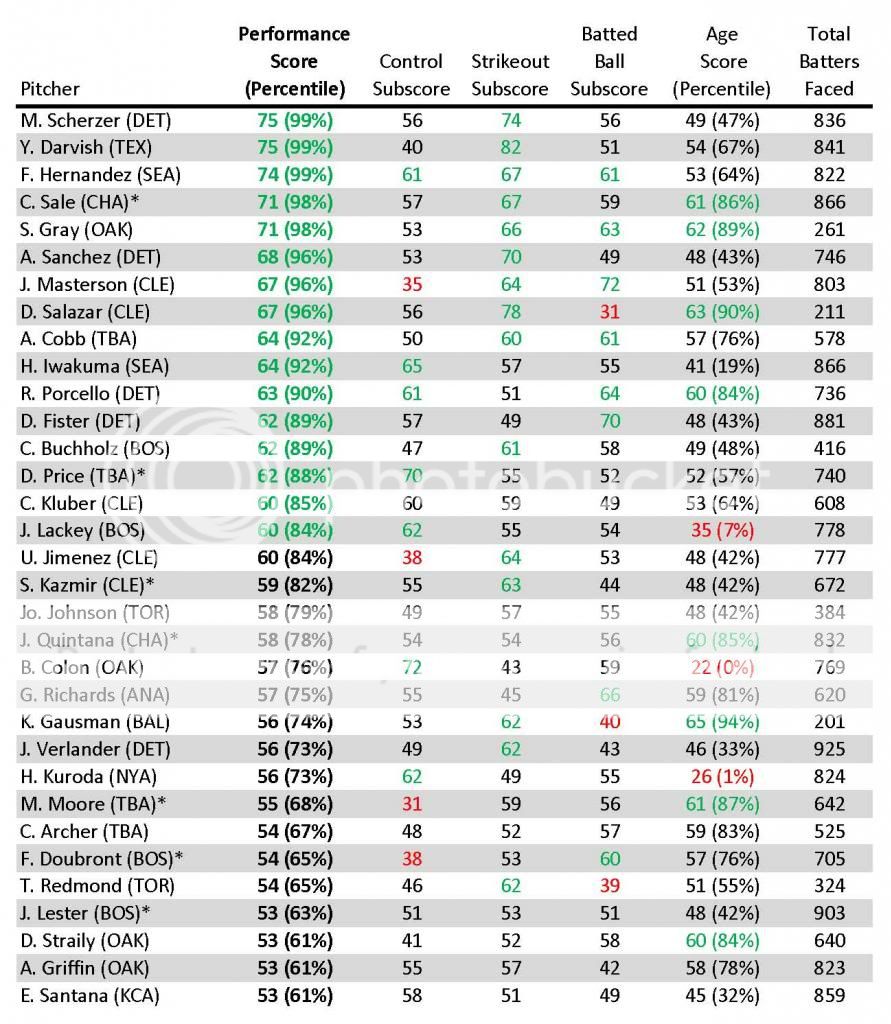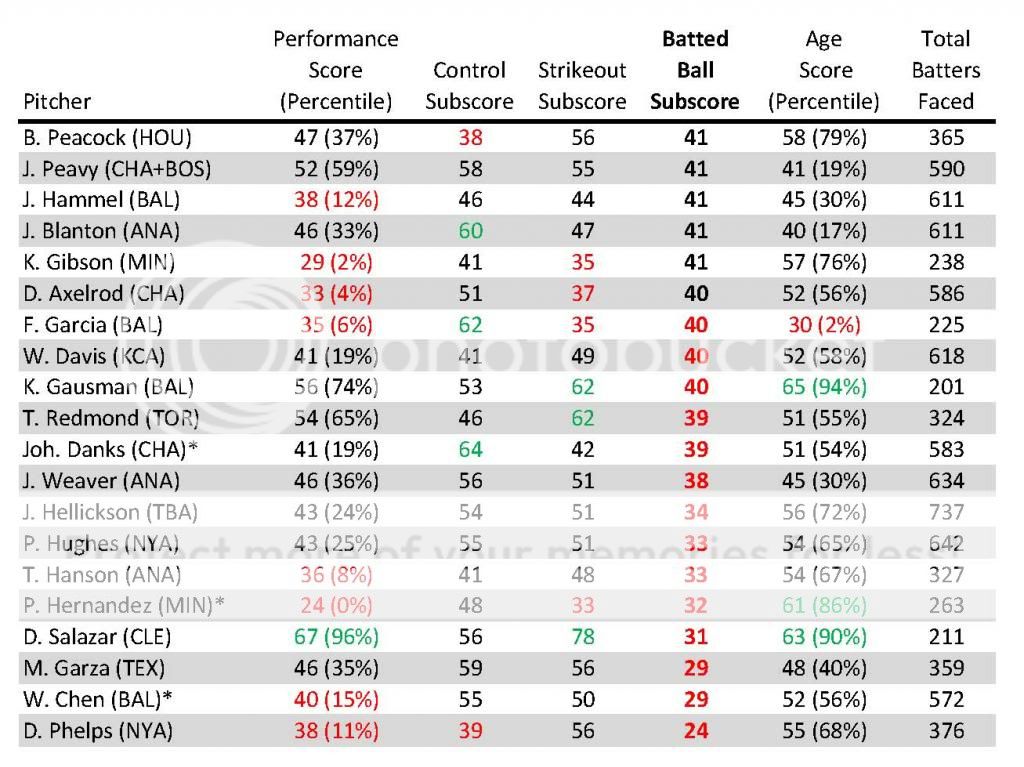Contract Modeling for the 2014 Free Agent Class
After Matt Garza reportedly signed with the Brewers for $52 Million over 4 years today, the initial response was that it was a steal. Baseball writer Joe Sheehan tweeted that the signing was “Grand Theft Pitcher“. Sure, a day after the Yankees spent $175 Million on a big question mark, the price for Garza looks like a bargain. Upon closer analysis, however, the deal appears to be pretty close to what we should expect given what we know about the cost of a win, inflation, and aging curves. This can be seen by using the same model that Dave Cameron writes about so frequently.
| Year | Salary (M) | Cost of Win (M) | Wins / Salary | Steamer WAR |
| 2014 | $13 | $6.00 | 2.17 | 2.8 |
| 2015 | $13 | $6.30 | 2.06 | 2.3 |
| 2016 | $13 | $6.62 | 1.97 | 1.8 |
| 2017 | $13 | $6.95 | 1.87 | 1.3 |
| Total | $52 | 8.07 | 8.20 |
This model assumes that in 2014, a win costs $6 million dollars, and that the cost of a win will increase by 5% each year. Steamer projects Garza for 2.8 WAR in 2014, and I subtracted 0.5 WAR each year to account for age-related decline. As with the Kershaw contract, the model pretty much nails the cost for four years of Garza. The deal appears to be slightly team-friendly, with the Brewers getting 0.13 wins of value over the course of the contract. Put in money terms, they saved about $800K for Garza’s expected production. His health concerns (he has totaled 259 innings in the past two seasons) mean extra risk for the team, making it tough for me to get really excited about the contract. According to the model, the Brewers pretty much paid market value for Matt Garza.
But despite the numbers in front of me (and you), the contract does feel like a bargain. Why is this the case? This brought me to the greater point of this article, which was to try to find out the real market value for the 2014 free agent class. To do this, I applied the same model explained above to the 14 major contracts that have been signed this offseason by MLB free agents. These contracts are all include at least 3 years and $20M guaranteed, and total nearly $1 Billion. This leaves out relievers (which never quite fit into the model), injury-prone bounce-back candidates like Josh Johnson, and of course Masahiro Tanaka (since he’s extremely difficult to project). Ten of the fourteen players are between the ages of 29 and 31. For 2014 WAR, I used an average of Steamer and ZiPS (where available), and in the few instances where there was a team option or buy-out, I included the cost of the buy-out in the final year of the contract, as players in their mid-30s are rarely worth the cost of the option year. Lastly, rather than projecting the money a player should have earned, I simply calculated the WAR that a player is being paid to be worth (Wins / Salary) and compared it to their projected WAR for the duration of the contract. Without further ado, the table:
| Player | Salary (M) | Wins / Salary | Projected WAR | Net Wins |
| Robinson Cano | $240 | 32.43 | 31.00 | -1.43 |
| Jacoby Ellsbury | $153 | 22.03 | 17.15 | -4.88 |
| Shin-Soo Choo | $130 | 18.55 | 9.80 | -8.75 |
| Brian McCann | $85 | 12.88 | 12.25 | -0.63 |
| Curtis Granderson | $60 | 9.28 | 5.80 | -3.48 |
| Jhonny Peralta | $53 | 8.29 | 8.00 | -0.29 |
| Matt Garza | $52 | 8.07 | 8.20 | 0.13 |
| Ricky Nolasco | $49 | 7.59 | 5.60 | -1.99 |
| Carlos Beltran | $45 | 6.58 | 4.05 | -3.25 |
| Omar Infante | $32 | 4.92 | 4.60 | -0.32 |
| Scott Feldman | $30 | 4.80 | 4.80 | 0.00 |
| Carlos Ruiz | $26 | 4.13 | 6.90 | 2.77 |
| James Loney | $21 | 3.32 | 1.80 | -1.52 |
| Jarrod Saltalamacchia | $21 | 3.32 | 3.75 | 0.43 |
| Total | $997 | 146.20 | 123.70 | -23.22 |
While your first instinct may be to declare most of these contracts huge overpays, the fact of the matter is that if everything appears to be an overpay, we need to adjust our baseline. According to the model, teams have paid for 146 wins, but are only projected to get back 124. What could account for the difference between the model and reality? On one hand, we have to consider the fact that every team values a win slightly differently. The Yankees have a huge incentive to put together a competitive team or they risk alienating an impatient fanbase. A win is worth more to a team on the brink of contention than a team sitting at the bottom of its division. This could be driving much of the variation, but is impossible to fully account for.
This leaves us with four factors that could cause the discrepancy between the model and the market that we can adjust for. First is the initial evaluations of the players. For instance, Shin-Soo Choo is coming off of a 5.2 WAR season, but is projected for just 2.9 WAR by Steamer. If we pencil Choo in as a 3.5 WAR player in 2014 (Oliver has him at 5.4), then he is set to produce 14 WAR during his 7-year contract, and be worth “only” -4.55 wins relative to his contract. The second is player aging. Taking off half a win each year is a quick and relatively accurate way to calculate future WAR for players who are already around 30 years old. However, some research has suggested that elite players may peak later and/or decline slower, which could affect many of these high-priced free agents (at least for the first few years of the contract).
The third and fourth variables are the cost of a win in the present and in the future. We’re using $6 Million per win, but other research has suggested that a win may cost more like $7 Million. In addition, the model increases the cost of a win by 5% each year, and some teams might suspect that rate to be higher with all the additional money flowing into the league.
After fixing the biggest outlier of the table (by projecting Choo for 3.5 WAR in 2014), these are the adjustments that would have to be made to a single variable (with all others held constant) to give us a model that properly values this free agent class so far:
Player Evaluation: The team signing the contract expects the player to perform roughly 0.23 WAR better than the Steamer/ZiPS projects in 2014.
Player Aging: The team signing the contract expects the player to decline at roughly 0.37 WAR per season.
Present Cost of a Win: One win (+1 WAR from a player) is currently worth $6.9 Million on the open market.
Future Cost of a Win: The cost of a win is expected to increase by 11.5% each year for the life of the contracts.
As is usually the case, the truth probably lies somewhere in between, with a little bit of each. In some cases, the driving force may be different for each team and each contract. The Mets may have signed Granderson believing that he can be worth 2.6 WAR in 2014 (as opposed to 2.2 from the projection systems), while the Mariners may have agreed with Steamer and ZiPS that Robinson Cano will be worth 5.35 WAR in 2014, but might project him for a slightly slower decline.
Just for fun, I’ll take a shot at modifying the model with a few minor adjustments so that the expected wins purchased matches the expected production. For my updated model, I’ll use the following parameters: Steamer/Zips are accurate measures of current talent, the players signed will decline 0.45 WAR per season after 2014, a win currently costs $6.4 Million, and the cost of a win will rise by 6% in the foreseeable future. Here’s the adjusted table:
| Player | Salary (M) | Wins / Salary | Projected WAR | Net Wins |
| Robinson Cano | $240 | 29.26 | 33.25 | 3.99 |
| Jacoby Ellsbury | $153 | 20.10 | 18.20 | -1.90 |
| Shin-Soo Choo | $130 | 16.90 | 15.05 | -1.85 |
| Brian McCann | $85 | 11.86 | 12.75 | 0.89 |
| Curtis Granderson | $60 | 8.58 | 6.10 | -2.48 |
| Jhonny Peralta | $53 | 7.68 | 8.30 | 0.62 |
| Matt Garza | $52 | 7.46 | 8.50 | 1.04 |
| Ricky Nolasco | $49 | 7.02 | 5.90 | -1.12 |
| Carlos Beltran | $45 | 6.64 | 4.05 | -2.59 |
| Omar Infante | $32 | 4.54 | 4.90 | 0.36 |
| Scott Feldman | $30 | 4.46 | 4.95 | 0.49 |
| Carlos Ruiz | $26 | 3.83 | 7.05 | 3.22 |
| James Loney | $21 | 3.08 | 1.95 | -1.13 |
| Jarrod Saltalamacchia | $21 | 3.08 | 3.90 | 0.82 |
| Total | $997 | 134.49 | 134.85 | 0.36 |
Reducing the rate of decline and increasing the cost of a win helps out the longer contracts quite a bit, so Robinson Cano’s contract starts to look a lot better. However, the net benefit is largely offset by committing such a massive amount of money to a single player who could get seriously injured or decline sooner than expected. With the new model, the Garza deal looks more like a bargain (although I would still hardly call it a steal), and a few contracts that looked like a market value or a slight overpay appear to be more team-friendly than initially anticipated (McCann, Peralta, Infante, Feldman, and Saltalamacchia). Carlos Ruiz looks like a downright steal. Keep in mind that even just netting half a win translates into an extra $3 Million of value, so we’re talking about a pretty significant savings here.
In closing, Cameron’s quick-and-dirty model works quite well, but given the contracts signed so far this season, appears to require some minor adjustment. It’s impossible to know which of the factors require adjusting and how they vary from one team to another, which is what makes projecting these contracts and determining whether a contract is a bargain or an overpay so difficult. As is always the case, only time will tell, and as more free agents sign we’ll be able to see if the new model checks out and make necessary adjustments.
All projections are from Steamer and ZiPS. Contract information is from Fangraphs and Baseball-Reference.












